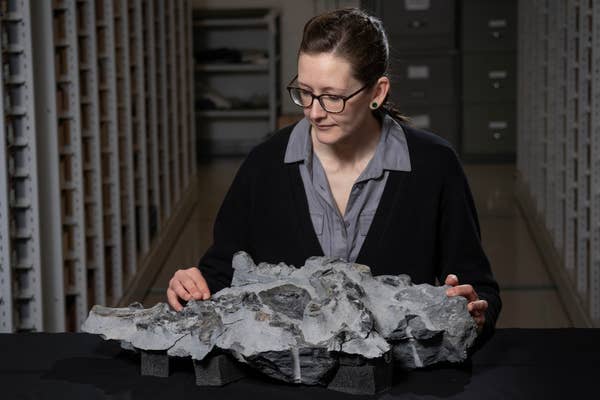
A Jurassic dinosaur fossil, first discovered more than five decades ago, has finally been unearthed from a cliff base on the Isle of Skye.
The fossil, dubbed the Elgol dinosaur, represents Scotland’s earliest recorded dinosaur, discovered near Elgol in the island’s south in 1973.
Despite its initial discovery, the fossil remained embedded in the cliff until a team led by Elsa Panciroli initiated an extraction effort in 2018. Early assessments suggested retrieval would be too challenging. However, with the crucial assistance of a local boat company, the team successfully extracted the fossil, raising hopes for further discoveries on Skye.
Dating back to the Middle Jurassic period, the Elgol dinosaur is fragmented. Researchers have identified parts of the spine, ribs, and a hip bone, classifying it as the most complete dinosaur skeleton yet found in Scotland.
Bone analysis has led researchers to believe it is an ornithopod dinosaur, a group which includes notable later dinosaurs such as Iguanodon, Parasaurolophus and Edmontosaurus.

It is one of the earliest known ornithopod body fossils, as that group of dinosaurs became far more prominent in the later Cretaceous period.
Analysis of the bone structure indicates the dinosaur, which would have been roughly the size of a pony, was at least eight years old.
The new description of the Elgol dinosaur is published in the Earth and Environmental Science Transactions of the Royal Society of Edinburgh.
Ms Panciroli, the lead author and Natural Environment Research Council independent research fellow at National Museums Scotland, said: “This was a really challenging extraction, in fact we’d previously felt it was too difficult to collect the fossil, but I thought it was really important to study it.
“I was able to persuade the team to give it a try. It took a lot of hard work from a lot of people, but we did it: finally we can confirm and publish Scotland’s first recorded and most complete dinosaur, and that makes it all worthwhile.”
The excavation was possible with the support of a specialist team from Research Casting International, based in Canada, while a crew from Elgol’s Bella Jane Boat Trips piloted the rigid inflatable boat and dingy to the shore at the foot of the cliff, where the specimen was loaded and taken back to port.
Stig Walsh from National Museums Scotland said: “This is a wonderful addition to the rapidly growing set of Jurassic finds from the Isle of Skye which are enabling us to learn more and more about the rich ecosystem of the time.
“We’ve known there were dinosaurs there for a while, most obviously from the famous footprints at An Corran, Brother’s Point and Duntulm and individual bones, but it’s exciting to see a more complete, if still partial, skeleton.
“We’re delighted to add it to the other amazing finds now in the national collection.”
Other Jurassic discoveries from Skye include the description of adult and juvenile mammals of the same species, Krusatodon, which revealed the mammals grew more slowly than mammals today, and the world’s largest Jurassic pterosaur fossil, Dearc sgiathanach.
Professor Susie Maidment, of the Natural History Museum and the University of Birmingham, said: “The Elgol dinosaur was a challenge to collect, and has proven perhaps an even bigger challenge to identify. Some aspects of the bones indicate that the specimen may be an ornithopod, a group of plant-eating dinosaurs that are best known from the Cretaceous.
“This specimen, however, would already have been a fossil by the time the better-known ornithopods like Iguanodon and Hypsilophodon were walking the Earth.
“Recent research on the fossils of Elgol has revealed a diverse ecosystem of extraordinarily preserved Middle Jurassic animals, and I’m sure there are more exciting discoveries to come.”
Professor Rob Ellam, editor of Earth and Environmental Science Transactions of the Royal Society of Edinburgh, said: “I would like to congratulate Dr Panciroli and her international team of co-authors.
“Having this exceptional piece of work on the Elgol dinosaur – both Scotland’s earliest and most complete dinosaur fossil – in the pages of Transactions is a highlight for the journal.
“It is a privilege to be able to publish a world-class study led from Scotland which illustrates why the Scottish palaeontological community is held in such high esteem.”







